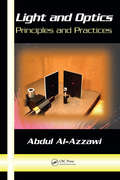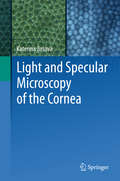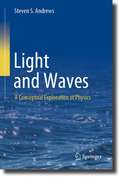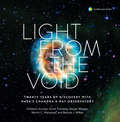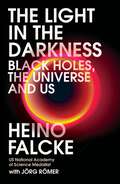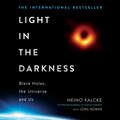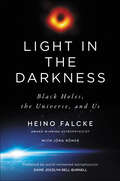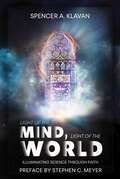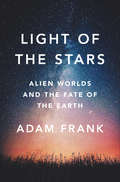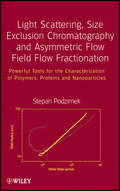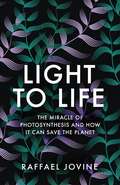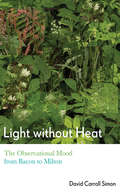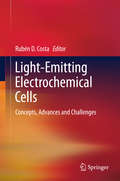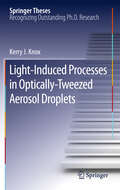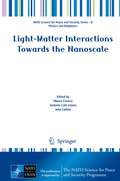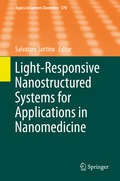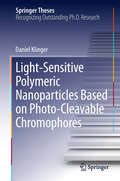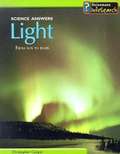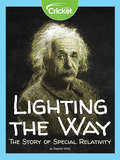- Table View
- List View
Light and Optics: Principles and Practices
by Abdul Al-AzzawiSince the invention of the laser, our fascination with the photon has led to one of the most dynamic and rapidly growing fields of technology. As the reality of all-optical systems quickly comes into focus, it is more important than ever to have a thorough understanding of light and the optical components used to control it. Comprising chapters drawn from the author's highly anticipated book Photonics: Principles and Practices, Light and Optics: Principles and Practices offers a detailed and focused treatment for anyone in need of authoritative information on this critical area underlying photonics.Using a consistent approach, the author leads you step-by-step through each topic. Each skillfully crafted chapter first explores the theoretical concepts of each topic, and then demonstrates how these principles apply to real-world applications by guiding you through experimental cases illuminated with numerous illustrations. The book works systematically through light, light and shadow, thermal radiation, light production, light intensity, light and color, the laws of light, plane mirrors, spherical mirrors, lenses, prisms, beamsplitters, light passing through optical components, optical instruments for viewing applications, polarization of light, optical materials, and laboratory safety. Containing several topics presented for the first time in book form, Light and Optics: Principles and Practices is simply the most modern, comprehensive, and hands-on text in the field.
Light and Sound: Reflection And Refraction
by Rebecca L. JohnsonLight is energy you can see. Light waves are transverse, and they move energy forward. Light waves can be absorbed, reflected, or refracted. Sound is energy you can hear. Sound waves are compression waves. They push together and spread apart. Properties of light and sound waves are wavelength, amplitude, and frequency.
Light and Specular Microscopy of the Cornea
by Katerina JirsovaThe atlas of the light and specular microscopy of the cornea, particularly of the corneal endothelium presents healthy and pathological corneas as well as corneas prepared for grafting; photographs are taken from donor or patient's corneas. The first section of the atlas shows healthy cornea and its particular layers: the epithelium (superficial and basal cells, subepithelial nerve plexus), stroma and keratocytes, and the endothelium. Blood vessels or palisades of Vogt in limbus are shown as well. The second section that shows corneas processed for grafting is focused on the endothelial layer. The main causes of exclusion of corneas from grafting, such as the presence of dead cells, polymeghatism, pleomorphism, cornea guttata or stromal scars have been shown. The third section shows corneas before and after storage in tissue cultures or hypothermic conditions with the aim to assess suitability of tissue for grafting. Finally, the last section contains photographs of pathological corneal explants.
Light and Waves: A Conceptual Exploration of Physics
by Steven S. AndrewsThis book explores light and other types of waves, using this as a window into other aspects of physics. It emphasizes a conceptual understanding, using examples chosen from everyday life and the natural environment. For example, it explains how hummingbird feathers create shimmering colors, how musical instruments produce sound, and how atoms stick together to form molecules. It provides a unique perspective on physics by emphasizing commonalities among different types of waves, including string waves, water waves, sound waves, light waves, the matter waves of quantum mechanics, and the gravitational waves of general relativity. This book is targeted toward college non-science majors, advanced high school students, and adults who are curious about our physical world. It assumes familiarity with algebra but no further mathematics and is classroom-ready with many worked examples, exercises, exploratory puzzles, and appendices to support students from a variety of backgrounds.
Light from the Void: Twenty Years of Discovery with NASA's Chandra X-ray Observatory
by Kimberly K. Arcand Megan Watzke Grant Tremblay Martin C. Weisskoph Belinda J. WilkesA lavish coffee-table book featuring spectacular images from the Chandra X-Ray Observatory, the most powerful X-Ray telescope ever builtTake a journey through the cosmos with Light from the Void, a stunning collection of photographs from the Chandra X-Ray Observatory's two decades of operation. The book showcases rarely-seen celestial phenomena such as black holes, planetary nebulae, galaxy clusters, gravitational waves, stellar birth and death, and more. Accompanying these images of incredible natural phenomena are captions explaining how they occur. The images start close to home and move outward: beginning with images of the Chandra launch, then moving into the solar system, through the nearby universe, and finally to the most distant galaxies Chandra has observed, the book brings readers on a far-out visual voyage.
Light in the Darkness: Black Holes, The Universe and Us
by Professor Heino Falcke Jörg RömerAs featured in THE EDGE OF ALL WE KNOW - the new Netflix documentary about Black HolesFor readers of Stephen Hawking, a fascinating account of the universe from the perspective of world-leading astrophysicist Heino Falcke, who took the first ever picture of a black hole.10th April 2019: a global sensation. Heino Falcke, a man "working at the boundaries of his discipline and therefore at the limits of the universe" had used a network of telescopes spanning the entire planet to take the first picture of a black hole.Light in the Darkness examines how mankind has always looked to the skies, mapping the journey from millennia ago when we turned our gaze to the heavens, to modern astrophysics. Heino Falcke and Jorg Romer entertainingly and compellingly chart the breakthrough research of Falcke's team, an unprecedented global community of international colleagues developing a telescope complex enough to look directly into a black hole - a hole where light vanishes, and time stops.What does this development mean? Is this the beginning of a new physics? What can we learn from this about God, the world, and ourselves? For Falcke, astrophysics and metaphysics, science and faith, do not exclude one another. Black Hole is both a plea for curiosity and humility; it's interested in both what we know, and the mysteries that remain unsolved.
Light in the Darkness: Black Holes, The Universe and Us
by Professor Heino Falcke Jörg RömerAs featured in THE EDGE OF ALL WE KNOW - the new Netflix documentary about Black HolesFor readers of Stephen Hawking, a fascinating account of the universe from the perspective of world-leading astrophysicist Heino Falcke, who took the first ever picture of a black hole.10th April 2019: a global sensation. Heino Falcke, a man "working at the boundaries of his discipline and therefore at the limits of the universe" had used a network of telescopes spanning the entire planet to take the first picture of a black hole.Light in the Darkness examines how mankind has always looked to the skies, mapping the journey from millennia ago when we turned our gaze to the heavens, to modern astrophysics. Heino Falcke and Jorg Romer entertainingly and compellingly chart the breakthrough research of Falcke's team, an unprecedented global community of international colleagues developing a telescope complex enough to look directly into a black hole - a hole where light vanishes, and time stops.What does this development mean? Is this the beginning of a new physics? What can we learn from this about God, the world, and ourselves? For Falcke, astrophysics and metaphysics, science and faith, do not exclude one another. Black Hole is both a plea for curiosity and humility; it's interested in both what we know, and the mysteries that remain unsolved.(P)2021 Headline Publishing Group Limited
Light in the Darkness: Black Holes, the Universe, and Us
by Heino Falcke Jörg RömerAn astrophysicist chronicles his quest to photograph a black hole and reflects on its spiritual ramifications in this international-bestselling memoir.On April 10, 2019, award-winning astrophysicist Heino Falcke presented the first image ever captured of a black hole at an international press conference—a turning point in astronomy that Science magazine called the scientific breakthrough of the year. That photo was captured with the unthinkable commitment of an intercontinental team of astronomers who transformed the world into a global telescope. While this image achieved Falcke’s goal in making a black hole “visible” for the first time, he recognizes that the photo itself asks more questions for humanity than it answers.Light in the Darkness takes us on Falcke’s extraordinary journey to the darkest corners of the universe. From the first humans looking up at the night sky to modern astrophysics, from the study of black holes to the still-unsolved mysteries of the universe, Falcke asks, in even the greatest triumphs of science, is there room for doubts, faith, and a God? A plea for curiosity and humility, Light in the Darkness sees one of the great minds shaping the world today as he ponders the big, pressing questions that present themselves when we look up at the stars.
Light in the World of Nanotechnology: A Comprehensible Introduction to the Basics and Applications (essentials)
by Christian SchneiderThis essential gives an overview of the physical principles underlying nanotechnology, which today make it possible to use microscopic effects technologically. Methods are presented which allow the production of nanostructures with highest precision. In the last chapter the author gives an overview of exciting technological applications, starting with the use of nanotechnology-based effects in church glass windows to solar cells and CCD chips. This book is a translation of the original German 1st edition Licht in der Welt der Nanotechnologie by Christian Schneider, published by Springer Fachmedien Wiesbaden GmbH, part of Springer Nature in 2016. The translation was done with the help of artificial intelligence (machine translation by the service DeepL.com). A subsequent human revision was done primarily in terms of content, so that the book will read stylistically differently from a conventional translation. Springer Nature works continuously to further the development of tools for the production of books and on the related technologies to support the authors.
Light of the Mind, Light of the World: Illuminating Science Through Faith
by Spencer KlavanThe world is not a machine. Humanity is not a mistake. For centuries, a grim anti-human outlook has taken hold of the public imagination, teaching us all to view ourselves as random products of a cruel and uncaring natural world. Today, from apocalyptic environmentalism to twisted eugenics and dystopian bionic augmentation, movements are rising around the world to dispense with humanity or subordinate it to a pitiless mechanical logic. For many, it has come to seem as if the human spirit is obsolete, religious faith is illusory, and mankind is destined to be extinguished or surpassed. Some might even see the end of humanity as a good thing. But that is not our future. Light of the Mind, Light of the World tells a daring new story about how we got here, and how we can chart a better path forward. Surveying the history of science and faith from the astronomers of Babylon to the quantum physicists of postwar Europe and America, classicist and scholar Spencer A. Klavan argues that science itself is leading us not away from God but back to him, and to the ancient faith that places the human soul at the center of the universe. Reconciling the discoveries of science with the truths of the Bible, Klavan shows how the search for knowledge of the natural world can help illuminate the glories of its Creator, and how the latest developments in physics can help shatter the illusion of materialism.
Light of the Stars: Alien Worlds And The Fate Of The Earth
by Adam FrankAstrophysicist and NPR commentator on what the latest research on the existence and trajectories of alien civilizations may teach us about our own. Light of the Stars tells the story of humanity’s coming of age as we awaken to the possibilities of life on other worlds and their sudden relevance to our fate on Earth. Astrophysicist Adam Frank traces the question of alien life and intelligence from the ancient Greeks to the leading thinkers of our own time, and shows how we as a civilization can only hope to survive climate change if we recognize what science has recently discovered: that we are just one of ten billion trillion planets in the Universe, and it’s highly likely that many of those planets hosted technologically advanced alien civilizations. What’s more, each of those civilizations must have faced the same challenge of civilization-driven climate change. Written with great clarity and conviction, Light of the Stars builds on the inspiring work of pioneering scientists such as Frank Drake and Carl Sagan, whose work at the dawn of the space age began building the new science of astrobiology; Jack James, the Texas-born engineer who drove NASA’s first planetary missions to success; Vladimir Vernadsky, the Russian geochemist who first envisioned the Earth’s biosphere; and James Lovelock and Lynn Margulis, who invented Gaia theory. Frank recounts the perilous journey NASA undertook across millions of miles of deep space to get its probes to Venus and Mars, yielding our first view of the cosmic laws of planets and climate that changed our understanding of our place in the universe. Thrilling science at the grandest of scales, Light of the Stars explores what may be the largest question of all: What can the likely presence of life on other worlds tell us about our own fate?
Light scattering, size exclusion chromatography and asymmetric flow field flow fractionation
by Stepan PodzimekA comprehensive, practical approach to three powerful methods of polymer analysis and characterization This book serves as a complete compendium of three important methods widely used for the characterization of synthetic and natural polymers--light scattering, size exclusion chromatography (SEC), and asymmetric flow field flow fractionation (A4F). Featuring numerous up-to-date examples of experimental results obtained by light scattering, SEC, and A4F measurements, Light Scattering, Size Exclusion Chromatography and Asymmetric Flow Field Flow Fractionation takes an all-in-one approach to deliver a complete and thorough explanation of the principles, theories, and instrumentation needed to characterize polymers from the viewpoint of their molar mass distribution, size, branching, and aggregation. This comprehensive resource: Is the only book gathering light scattering, size exclusion chromatography, and asymmetric flow field flow fractionation into a single text Systematically compares results of size exclusion chromatography with results of asymmetric flow field flow fractionation, and how these two methods complement each other Provides in-depth guidelines for reproducible and correct determination of molar mass and molecular size of polymers using SEC or A4F coupled with a multi-angle light scattering detector Offers a detailed overview of the methodology, detection, and characterization of polymer branching Light Scattering, Size Exclusion Chromatography and Asymmetric Flow Field Flow Fractionation should be of great interest to all those engaged in the polymer analysis and characterization in industrial and university research, as well as in manufacturing quality control laboratories. Both beginners and experienced can confidently rely on this volume to confirm their own understanding or to help interpret their results.
Light to Life: The miracle of photosynthesis and how it can save the planet
by Raffael Jovine"Read this book and you will learn how photosynthesis was discovered, how it works, and how we can produce more food to feed the world." - PAUL NURSE, Nobel Prize winner and author of What is Life?In Light to Life, biologist Raffael Jovine takes us on a journey of discovery into the intricate, beautiful and often surprising processes that convert energy from the sun into life and how all-important these are to our survival.Despite the unprecedented challenges the Earth faces from global warming, habitat loss, air pollution and population growth; Jovine shows us that there is hope to be found. Photosynthesis is the very source of life: it has the power not just to produce food, but to reshape continents, drive biogeochemical cycles, stabilise the climate and regulate weather.In this exciting, revelatory book, Jovine unveils a blueprint for the future: greening the desert, bringing the ocean on land, planting mangrove forests and oyster banks, growing algae for animal feed, human food and soil carbon... He demonstrates how by harnessing photosynthesis we can regenerate the planet and revise the way we human beings interact with it.This book will help you to see the world in a different way, in all its wonderful detail - through the photosynthetic pigments in your eyes.
Light without Heat: The Observational Mood from Bacon to Milton
by David Carroll SimonIn Light without Heat, David Carroll Simon argues for the importance of carelessness to the literary and scientific experiments of the seventeenth century. While scholars have often looked to this period in order to narrate the triumph of methodical rigor as a quintessentially modern intellectual value, Simon describes the appeal of open-ended receptivity to the protagonists of the New Science. In straying from the work of self-possession and the duty to sift fact from fiction, early modern intellectuals discovered the cognitive advantages of the undisciplined mind.Exploring the influence of what he calls the "observational mood" on both poetry and prose, Simon offers new readings of Michel de Montaigne, Francis Bacon, Izaak Walton, Henry Power, Robert Hooke, Robert Boyle, Andrew Marvell, and John Milton. He also extends his inquiry beyond the boundaries of early modernity, arguing for a literary theory that trades strict methodological commitment for an openness to lawless drift.
Light-Emitting Electrochemical Cells
by Rubén D. CostaThis book presents the recent achievements towards the next generation of Light-emitting electrochemical cells (LEC). Its first part focus on the definition, history and mechanism of LEC, going then to concepts and challenges and, finally, giving the reader examples of current application of new electroluminescent materials. The chapters are written by different international groups working on LEC.
Light-Induced Processes in Optically-Tweezed Aerosol Droplets
by Kerry J. KnoxAerosols play a critical role in a broad range of scientific disciplines, such as atmospheric chemistry and physics, combustion science, drug delivery and human health. This thesis explores the fundamentals of a new technique for capturing single or multiple particles using light, and for characterising these particles by Raman or fluorescence spectroscopy. The outcome of this research represents a significant development in optical manipulation techniques, specifically in optical tweezing. These findings can be applied to studies of the mass accommodation of gas-phase water molecules adsorbing onto a water surface. Not only is this a fundamental process of interest to physical chemists, but it is important for understanding the role of aerosol particles in the atmosphere, including their ability to become cloud droplets. This new strategy for investigating aerosol dynamics is fundamental in helping us understand the indirect effect of aerosols on the climate.
Light-Matter Interactions Towards the Nanoscale (NATO Science for Peace and Security Series B: Physics and Biophysics)
by John Collins Maura Cesaria Antonio Calà LesinaThe investigation of light-matter interactions in materials, especially those on the nanoscale, represents perhaps the most promising avenue for scientific progress in the fields of photonics and plasmonics. This book examines a variety of topics, starting from fundamental principles, leading to the current state of the art research. For example, this volume includes a chapter on the sensing of biological molecules with optical resonators (microspheres) combined with plasmonic systems, where the response this system are described in a fundamental and elegant manner using coupled mode theory. Symmetry plays a major role in the book. One chapter on time reversal symmetry in electromagnetic theory describes how to control the properties of light (e.g. scattering and directionality of the flow of light) in materials with certain topological invariants. Another chapter where symmetry is prominent reformulates, using a gentle and pedagogical approach, Maxwell’s Equations into a new set of fields that reveal a “handedness” symmetry in electromagnetic theory, which can be applied to photonic systems in, for example, the sensing of chiral molecules and understanding the conditions for zero reflection. Also, for students and researchers starting in the field of nanoplasmonics, the book includes a tutorial on the finite element time domain simulation of nanoplasmonic systems. Other topics include photonic systems for quantum computing, nanoplasmonics, and optical properties of nano and bulk materials. The authors take a pedagogical approach to their topic, making the book an excellent reference for graduate students and scientists starting in the fields of photonics or plasmonics.
Light-Responsive Nanostructured Systems for Applications in Nanomedicine
by Salvatore SortinoThe series Topics in Current Chemistry presents critical reviews of the present and future trends in modern chemical research. The scope of coverage is all areas of chemical science including the interfaces with related disciplines such as biology, medicine and materials science. The goal of each thematic volume is to give the non-specialist reader, whether in academia or industry, a comprehensive insight into an area where new research is emerging which is of interest to a larger scientific audience. Each review within the volume critically surveys one aspect of that topic and places it within the context of the volume as a whole. The most significant developments of the last 5 to 10 years are presented using selected examples to illustrate the principles discussed. The coverage is not intended to be an exhaustive summary of the field or include large quantities of data, but should rather be conceptual, concentrating on the methodological thinking that will allow the non-specialist reader to understand the information presented. Contributions also offer an outlook on potential future developments in the field. Review articles for the individual volumes are invited by the volume editors. Readership: research chemists at universities or in industry, graduate students.
Light-Sensitive Polymeric Nanoparticles Based on Photo-Cleavable Chromophores
by Daniel KlingerThe triggered release of functional compounds from such polymeric carriers as micelles, nanoparticles or nanogels is a rapidly developing and highly versatile concept which is expected to be one of the key approaches to future therapeutics. In his thesis, Daniel Klinger highlights the approach of stimuli-responsive microgels for such applications and discusses why especially light as a trigger has an outstanding position amongst the family of conventional stimuli. Based on these considerations, the author focuses on the design, synthesis and characterization of novel photo-sensitive microgels and nanoparticles as potential materials for the loading and light-triggered release/accessibility of functional compounds. Starting from the synthesis of photo-cleavable organic building blocks and their use in the preparation of polymeric nanoparticles, continuing to the examination of their loading and release profiles, and concluding with biological in vitro studies of the final materials, Daniel Klinger's work is an excellent example of the multidisciplinary research needed for the successful development of new materials in this field and has led to a number of further publications in internationally respected journals.
Light: From Sun to Bulbs
by Christopher CooperWhat is light? Why do we see different colors? Why we appear upside down in some mirrors? Investigate the dazzling world of physical science! Find out for yourself about light through experiments that you can do at home. Did you know that white light is made up of many colors? Light will show you the importance of investigating and understanding the physical world around you.
Light: Physical Science)
by Adele D. RichardsonProvides an introduction to light, including its components, forms, and movement, as well as humans' perception of light.
Lighthouse Tales
by Frederick StonehouseFrom the Book Jacket: Lighthouse Tales tells the story of the exciting human side of lightkeeping. It describes the deadly storms, killing fogs and numbing loneliness those who "kept the lights" endured. Stories of wreck and rescue, death and sacrifice, all thread their way through the pages of this remarkable tribute to the "wickies" of a bygone era. The book speaks of the courage of the old time keepers and their families, not just in rescuing shipwreck victims but also in the tenacity of their daily lives. Lighthouse Tales will appeal greatly to anyone interested in the wonders of the Great Lakes, historians, sailors, lighthouse fanatics and people just looking for a roaring good story. The book is thoroughly illustrated with rare photographs. Narratives include: The thrilling story of the steamer GEORGE W. PERKINS and it's close encounter with Lansing Shoal Light during the height of the infamous 1940 Armistice Day storm. Superior Shoal and the lighthouse that wasn't. The death of six brave Coast Guardsmen at Oswego, New York in 1942. Poverty Island Light and the mysterious treasure. And many more thrilling tales of "keeping the lights!"
Lighting Up the Brain: The Science of Optogenetics
by Marc ZimmerWhat if neuroscientists could look inside the human brain and watch individual brain cells send signals to one another? What if they could then control these brain cells to direct thoughts and actions? This may sound like science fiction, but it's actually a scientific revolution called optogenetics. Neuroscientists would like to use this new technology on human brains to uncover secrets about how the brain processes information and drives human behavior. Doctors hope to use optogenetics to restore sight and to treat Alzheimer's disease, Parkinson's disease, depression, and other debilitating or deadly health problems. Discover how the innovative work of leaders in the field is poised to radically transform science, medicine, and human health.
Lighting the Way: The Story of Special Relativity
by Stephen WhittWhat is a light beam? What are photon particles? What are all things made of? These are questions young Einstein asked himself; questions that would change our world forever. Travel along with young Einstein to learn about his discoveries, still in motion today!
Lightning
by Vladimir A. Rakov Martin A. UmanComplete and comprehensive, this text for advanced undergraduates in physics and engineering features exceptional clarity and minimum of mathematic notation. Topics include lightning phenomena and terminology, lightning photography, lightning spectroscopy, electrical and magnetic field measurements and current measurements, and more. 140 figures and tables.
